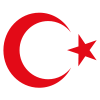Economy of Turkey
| Economy of Turkey | |
|---|---|
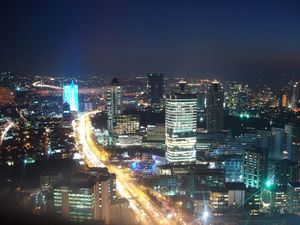 |
|
| Currency | Turkish lira (TRY)[1] |
| Fiscal year | calendar year |
| Trade organisations | G-20 major economies, OECD, EU Customs Union, WTO, ECO, BSEC |
| Statistics | |
| GDP | $880.061 billion[2] (2009 est.) |
| GDP growth | -5.6% (2009 est.) 11.7% (Q1 2010) |
| GDP per capita | $12,476[2] (2009 est.) |
| GDP by sector | agriculture: 9.4%; industry: 25.9%; services: 64.7% (2009 est.) |
| Inflation (CPI) | 5.53%[3] (November 2009) |
| Gini index | 41 (2007) |
| Labour force | 25.3 million (2009 est.) note: about 1.2 million Turks work abroad |
| Labour force by occupation |
agriculture: 29.5%, industry: 24.7%, services: 45.8%[4] (2005) |
| Unemployment | 14.5%[4] (2009 est.) |
| Main industries | textiles, food processing, autos, electronics, mining (coal, chromate, copper, boron), steel, petroleum, construction, lumber, paper |
| External | |
| Exports | $102.2 billion (2009 est.) |
| Export goods | apparel, foodstuffs, textiles, metal manufactures, transport equipment |
| Main export partners | Germany 9.6%, France 6.1%, U.K. 5.8%, Italy 5.8%, Iraq 5% (2009 est.) |
| Imports | $140.8 billion (2009 est.) |
| Import goods | machinery, chemicals, semi-finished goods, fuels, transport equipment |
| Main import partners | Russia 14%, Germany 10%, China 9%, U.S. 6.1%, Italy 5.4%, France 5% (2009 est.) |
| FDI stock | $205 billion (31 December 2009 est.) |
| Gross external debt | $274 billion (31 December 2009 est.) |
| Public finances | |
| Public debt | 48.5% of GDP (2009 est.) |
| Revenues | $145.3 billion (2009) |
| Expenses | $180.6 billion (2009) |
| Foreign reserves | $75.3 billion (31 December 2009 est.) |
| Main data source: CIA World Fact Book All values, unless otherwise stated, are in US dollars |
|
The economy of Turkey is largely developed. The country is among the world's leading producers of agricultural products; textiles; motor vehicles, ships and other transportation equipment; construction materials; consumer electronics and home appliances. In recent years, Turkey had a rapidly growing private sector, yet the state still plays a major role in industry, banking, transport, and communications.
Contents |
Macro-economic trends
Turkey has the world's 15th largest GDP-PPP[5] and 17th largest Nominal GDP.[6] The country is a founding member of the OECD (1961) and the G-20 major economies (1999). Since December 31, 1995, Turkey is also a part of the EU Customs Union.
The CIA classifies Turkey as a developed country.[7] Turkey is often classified as a newly industrialized country by economists and political scientists;[8][9][10] while Merrill Lynch, the World Bank and The Economist magazine describe Turkey as an emerging market economy.[11][12][13]
The World Bank classifies Turkey as an upper-middle income country in terms of the country's per capita GDP in 2007.[13] According to a survey by Forbes magazine, Istanbul, Turkey's financial capital, had a total of 28 billionaires as of March 2010 (down from 35 in 2008), ranking 4th in the world behind Moscow (50 billionaires), New York City (60 billionaires) and London (32 billionaires).[14]
Effect of the Global Financial Crisis
Like many economies, the Turkish economy has been affected by the global financial crisis with its Finance Ministry reporting that Turkey's budget deficit swelled to 23.2 billion Turkish liras ($15 billion) in the first half of 2009, 13 times higher than a year earlier.[15]
Share prices in Turkey nearly doubled over the course of 2009. According to The Economist, in the period December 2008 - December 2009 the Turkish stockmarket rose the most in the world after Argentina's stockmarket.[16]
On 8 January 2010, International credit rating agency Moody's upgraded Turkey's rating with a notch.[17] The credit rating agency Fitch upgraded Turkey’s sovereign rating two notches to BB+. Turkey is one of the few countries that upgraded it's rating with two notches.
The Economist points out that:[12]
Yet in many ways Turkey has weathered the credit crunch better than other emerging economies. Partly thanks to tough regulation, not a single Turkish bank has gone under. That is also because, unlike many Western banks, they have few toxic assets and limited mortgage exposure. So the government has not had to divert public money into rescuing banks.
In 2009, the Turkish Government introduced various economic stimulus measures to reduce the impact of the financial crisis such as temporary tax cuts on automobiles, home appliances and housing. This resulted in the production of durable consumer goods increasing by 7.2% but automative production still fell.[18]
Main economic sectors
Agricultural sector
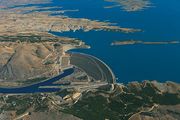
As of March 2007, Turkey is the world's largest producer of hazelnut, cherry, fig, apricot, quince and pomegranate; the second largest producer of watermelon, cucumber and chickpea; the third largest producer of tomato, eggplant, green pepper, lentil and pistacchio; the fourth largest producer of onion and olive; the fifth largest producer of sugar beet; the sixth largest producer of tobacco, tea and apple; the seventh largest producer of cotton and barley; the eighth largest producer of almond; the ninth largest producer of wheat, rye and grapefruit, and the tenth largest producer of lemon.[19] Turkey has been self-sufficient in food production since the 1980s. The agricultural output has been growing at a respectable rate. However, since the 1980s, agriculture has been in a state of decline in comparison to the total economy. Agricultural loans are issued with negative interest rates. Today, many of the institutions established between 1930 and 1980 continue to play important roles in the practices of farmers.
The country's large agricultural sector accounted for 11.2% of the employment in 2006.[19] Historically, Turkey's farmers have been fairly fragmented. According to the 1990 Census, "85% of agricultural holdings were under 10 hectares and 57% of these were fragmented into four or more non-contiguous plots."[20] Many old agricultural attitudes remain widespread, but these traditions are expected to change with the EU accession process. Turkey is dismantling the incentive system. Fertiliser and pesticide subsidies have been curtailed and remaining price supports have been gradually converted to floor prices. The government has also initiated many planned projects, such as the Southeastern Anatolia Project (G.A.P project). The advent of the G.A.P promises a very prosperous future for the southeastern agriculture.[21] The program includes 22 dams, 19 hydraulic power plants, and the irrigation of 1.82 million hectares of land.[22] The total cost of the project is estimated at $32 billion.[22] The total installed capacity of power plants is 7476 MW and projected annual energy production reaches 27 billion kWh.[22]
The livestock industry, compared to the initial years of the Republic, showed little improvement in productivity, and the later years of the decade saw stagnation. However, livestock products, including meat, milk, wool, and eggs, contributed to more than ⅓ of the value of agricultural output. Fishing is another important part of the economy; in 2005 Turkish fisheries harvested 545,673 tons of fish and aquaculture.[23]
Industrial sector
Consumer electronics and home appliances
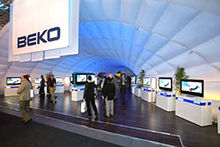
Turkey's Vestel Electronics is the largest TV producer in Europe, accounting for 21% of all TV sets manufactured and sold on the continent in 2007. [24] By January 2005, Vestel and its rival Turkish electronics and white goods brand BEKO accounted for more than half of all TV sets manufactured in Europe.[25] Another Turkish electronics brand, Profilo-Telra, was Europe's third largest TV producer in 2005.[26] EU market share of Turkish companies in consumer electronics has increased significantly following the Customs Union agreement signed between the EU and Turkey: in color TVs from 5% in 1995 to more than 50% in 2005, in digital devices from 3% to 15%, and in white goods from 3% to 18%.
Textiles and clothing
Turkish companies made clothing exports worth $13.98 billion in 2006; more than $10.67 billion of which (76.33%) were made to the EU member states.[27]
Motor vehicles and automotive products

Turkey has a large and growing automotive industry, which produced 1,024,987 motor vehicles in 2006,[28] ranking as the 7th largest automotive producer in Europe; behind Germany (5,819,614), France (3,174,260), Spain (2,770,435), the United Kingdom (1,648,388), Russia (1,508,358) and Italy (1,211,594), respectively.[29]
In 2008 Turkey produced 1,147,110 motor vehicles, ranking as the 6th largest producer in Europe (behind the United Kingdom and above Italy) and the 15th largest producer in the world.[30][31]
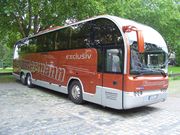
The automotive industry is an important part of the economy since the late 1960s. The companies that operate in the sector are mainly located in the Marmara Region. With a cluster of car-makers and parts suppliers, the Turkish automotive sector has become an integral part of the global network of production bases, exporting over $22,944,000,000 worth of motor vehicles and components in 2008.[32][33]
Shipbuilding
Turkey is also one of the leading shipbuilding nations; in 2007 Turkish shipyards ranked 4th in the world (behind China, South Korea and Japan) in terms of the number of ordered ships, and also 4th in the world (behind Italy, USA and Canada) in terms of the number of ordered mega yachts.[34]
Construction and contracting sector
The Turkish construction and contracting industry is one of the leading, most competitive and dynamic construction/contracting industries in the world. In 2007 a total of 22 Turkish construction/contracting companies were selected for the Top International Contractors List prepared by the Engineering News-Record, which made the Turkish construction/contracting industry the world's 3rd largest, ranking behind those of the USA and China.[35]
Service sector
Transport

As of 2009, there were 102 airports (90 with paved runways and 12 with unpaved runways) in Turkey, including the six international airports in Istanbul, Ankara, İzmir, Trabzon, Dalaman and Antalya.[36] There were also 21 heliports in the country during the same year.[36]
The rail network was 8,697 km in 2008, including 2,133 km of electrified track.[36] The Turkish State Railways started building high-speed rail lines in 2003. The first line, which has a length of 533 km from Istanbul (Turkey's largest metropolis) via Eskişehir to Ankara (the capital) is under construction and will reduce the travelling time from 6–7 hours to 3 hours and 10 minutes. The Ankara-Eskişehir section of the line, which has a length of 245 km and a projected travel time of 65 minutes, is completed. Trials began on April 23, 2007, and revenue earning service began on March 13, 2009. The Eskişehir-Istanbul section of the line is scheduled to be completed by 2009, and includes the Marmaray tunnel which will enter service in 2012 and establish the first direct railway connection between Europe and Anatolia.
In 2006 the country had a roadway network of 426,951 km, including 1,987 km of expressways, ranking 13th in the world.[36]
As of 2008, the Turkish merchant marine included 612 ships, ranking 19th in the world.[36] Turkey's coastline has 1,200 km of navigable waterways.[36]
In 2008, 7,555 kilometres (4,694 mi) of natural gas pipelines and 3,636 kilometres (2,259 mi) of petroleum pipelines spanned the country's territory.[36]
Communications
As of 2008, there were 17,502,000 operational main line telephones in Turkey, which ranked 18th in the world;[36] while there were 65,824,000 registered cell phones in the country, which ranked 15th in the world during the same year.[36]
The telecommunications liberalisation process started in 2004 after the creation of the Telecommunication Authority, and is still ongoing. Private sector companies operate in mobile telephony, long distance telephony and Internet access. Additional digital exchanges are permitting a rapid increase in subscribers; the construction of a network of technologically advanced intercity trunk lines, using both fiber-optic cable and digital microwave radio relay, is facilitating communication between urban centers.[36] The remote areas of the country are reached by a domestic satellite system, while the number of subscribers to mobile-cellular telephone service is growing rapidly.[36]
The main line international telephone service is provided by the SEA-ME-WE-3 submarine cable and by submarine fiber-optic cables in the Mediterranean and Black Seas that link Turkey with Italy, Greece, Israel, Bulgaria, Romania, and Russia.[36] In 2002, there were 12 Intelsat satellite earth stations; and 328 mobile satellite terminals in the Inmarsat and Eutelsat systems.[36]
As of 2001, there were 16 AM, 107 FM, and 6 shortwave radio stations in the country.[36]
As of 2008, there were 24,483,000 internet users in Turkey, which ranked 15th in the world;[36] while as of 2009, there were 2,961,000 internet hosts in the country, which ranked 27th in the world.[36]
Tourism sector

Tourism is one of the most dynamic and fastest developing sectors in Turkey. According to travel agencies TUI AG and Thomas Cook, 11 of the 100 best hotels of the world are located in Turkey.[37] In 2005, there were 24,124,501 visitors to the country, who contributed $18.2 billion to Turkey's revenues, with an average expenditure of $679 per tourist.[38] In 2008, the number of visitors rose to 30,929,192, who contributed $21.9 billion to Turkey's revenues.[39] Over the years, Turkey has emerged as a popular tourist destination for many Europeans, competing with Greece, Italy and Spain. Resorts in provinces such as Antalya and Muğla (which are located on the Turkish Riviera) have become very popular among European tourists.
Financial sector
The Central Bank of the Republic of Turkey (Türkiye Cumhuriyet Merkez Bankası) was founded in 1930, as a privileged joint-stock company. It possesses the sole right to issue notes. It also has the obligation to provide for the monetary requirements of the state agricultural and commercial enterprises. All foreign exchange transfers are exclusively handled by the central bank.
Originally established as the Ottoman Stock Exchange (Dersaadet Tahvilat Borsası) in 1866, and reorganized to its current structure at the beginning of 1986, the Istanbul Stock Exchange (ISE) is the sole securities market of Turkey.[40] During the 19th and early 20th centuries, Bankalar Caddesi (Banks Street) in Istanbul was the financial center of the Ottoman Empire, where the headquarters of the Ottoman Central Bank (established as the Bank-ı Osmanî in 1856, and later reorganized as the Bank-ı Osmanî-i Şahane in 1863)[41] and the Ottoman Stock Exchange (1866) were located.[42] Bankalar Caddesi continued to be Istanbul's main financial district until the 1990s, when most Turkish banks began moving their headquarters to the modern central business districts of Levent and Maslak.[42] In 1995, the Istanbul Stock Exchange moved to its current building in the Istinye quarter.[43] The Istanbul Gold Exchange was also established in 1995. The stock market capitalisation of listed companies in Turkey was valued at $161,537,000,000 in 2005 by the World Bank.[44]
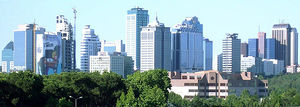
In 1998, there were 72 banks in Turkey. In late 2000 and early 2001 a growing trade deficit and weaknesses in the banking sector plunged the economy into crisis. There was a recession followed by the floating of the lira. This financial breakdown brought the number of banks to 31. Currently more than 34% of the assets are concentrated in the Agricultural Bank (Ziraat Bankası), Housing Bank (Yapı Kredi Bankası), Isbank (Türkiye İş Bankası) and Akbank. The five big state-owned banks were restructured in 2001. Political involvement was minimized and loaning policies were changed. There are also numerous international banks, which have branches in Turkey. A number of Arabian trading banks, which practice an Islamic banking, are also present in the country.
Government regulations passed in 1929 required all insurance companies to reinsure 30% of each policy with the Millî Reasürans T.A.Ş. (National Reinsurance Corporation) which was founded on February 26, 1929.[45] In 1954, life insurance was exempted from this requirement. The insurance market is officially regulated through the Ministry of Commerce.

After years of low levels of foreign direct investment (FDI), in 2007 Turkey succeeded in attracting $21.9 billion in FDI and is expected to attract a higher figure in following years.[46] A series of large privatizations, the stability fostered by the start of Turkey’s EU accession negotiations, strong and stable growth, and structural changes in the banking, retail, and telecommunications sectors have all contributed to the rise in foreign investment.
Since 2003, the inflation has lowered to single digits, and the economy is showing an average growth of 7.8%, between 2002-2005. Fiscal deficit is benefiting (though in small amount) from large industry privatizations. Banking came under stress beginning in October 2008 as Turkish banking authorities warned state-run banks against the pullback of loans from the larger financial sectors [47].
In recent years, the chronically high inflation has been brought under control and this has led to the launch of a new currency, the "New Turkish lira", on January 1, 2005, to cement the acquisition of the economic reforms and erase the vestiges of an unstable economy.[48] On January 1, 2009, the New Turkish lira was renamed once again as the "Turkish lira", with the introduction of new banknotes and coins.
Largest companies
In 2008, 14 Turkish companies were listed in the Forbes Global 2000 list - an annual ranking of the top 2000 public companies in the world by Forbes magazine.[49] The 10 leading companies were:
| World Rank | Company | Industry | Revenue (billion $) |
Profits (billion $) |
Assets (billion $) |
Market Value (billion $) |
|---|---|---|---|---|---|---|
| 371 | Türkiye İş Bankası | Banking | 12.53 | 1.26 | 61.19 | 12.89 |
| 384 | Akbank | Banking | 8.17 | 1.56 | 61.54 | 16.26 |
| 405 | Garanti Bankası | Banking | 8.13 | 1.85 | 65.48 | 12.69 |
| 639 | Koç Holding | Conglomerate | 34.84 | 0.40 | 40.12 | 6.69 |
| 690 | Sabancı Holding | Conglomerate | 11.95 | 0.35 | 47.60 | 8.27 |
| 879 | Turkcell | Telecommunications | 4.75 | 0.90 | 5.95 | 22.03 |
| 893 | Halk Bankası | Banking | 3.52 | 0.61 | 24.51 | 8.07 |
| 909 | VakıfBank | Banking | 4.23 | 0.57 | 27.35 | 5.96 |
| 990 | Tüpraş | Oil and gas | 14.19 | 0.58 | 4.93 | 6.48 |
| 1185 | Enka İnşaat | Construction | 4.06 | 0.41 | 5.38 | 13.85 |
External trade and investment
Turkey is one of the largest sources of foreign direct investment in central and eastern Europe and the CIS, with more than $1.5 billion invested in these countries. 32% has been invested in Russia, primarily in the natural resources and construction sector, and 46% in Turkey’s Black Sea neighbours, Bulgaria and Romania. Turkish companies also have sizable FDI stocks in Poland, at about $100 million.
The construction and contracting companies have been a significant player, such as Enka, Tekfen, Gama, and Üçgen İnşaat, as well as the three industrial groups, Anadolu Efes Group, ŞişeCam Group and Vestel Group.
The exports reached $115.3 billion in 2007, but imports rose to $162.1 billion, mostly due to the rising demand for energy resources like natural gas and crude oil.[4] Turkey targets exports of $200 billion in 2013, and a total trade of at least $450 billion.[50] There has been a considerable shift in exports in the last two decades. Share of natural gas decreased from 74% in 1980 to 30% in 1990 and 12% in 2005. Share of mid and high technology products has increased from 5% in 1980 to 14% in 1990 and 43% in 2005.
The main trading partners are the European Union, which accounted for 59% of exports and 52% of imports in 2005,[51] the United States, Russia and Japan. Turkey has taken advantage of a customs union with the European Union, signed in 1995, to increase industrial production for exports, while benefiting from EU-origin foreign investment into the country.[52]
Natural resources
Minerals
Turkey ranks tenth in the world in terms of the diversity of minerals produced in the country. Around 60 different minerals are currently produced in Turkey. The richest mineral deposits in the country are boron salts and Turkey’s reserves amount to 72% of the world’s total. According to the CIA World Factbook, other natural resources include coal, iron ore, copper, chromium, uranium, antimony, mercury, gold, barite, borate, celestine (strontium), emery, feldspar, limestone, magnesite, marble, perlite, pumice, pyrites (sulfur), clay, arable land, hydropower, and geothermal power.
Petroleum and natural gas
Turkey is an oil and natural gas producer, but the level of production isn't large enough to make the country self-sufficient, which makes Turkey a net importer of both oil and gas. However, the recent discovery of new oil and natural gas fields in the country, particularly off the Black Sea coast of northern Anatolia; as well as in Eastern Thrace, the Gulf of İskenderun and in the provinces of the Southeastern Anatolia Region near the borders with Syria and Iraq; will help Turkey to reach a higher degree of self-sufficiency in energy production.[53]
The pipeline network in Turkey included 1,738 kilometres (1,080 mi) for crude oil, for petroleum products, and 708 kilometres (440 mi) for natural gas in 1999. The Baku-Tbilisi-Ceyhan pipeline, the second longest oil pipeline in the world, was inaugurated on May 10, 2005. The pipeline delivers crude oil from the Caspian Sea basin to the port of Ceyhan on Turkey's Mediterranean coast, from where it is distributed with oil tankers to the world's markets. The planned Nabucco Pipeline will also pass from Turkey and provide the European Union member states with natural gas from the Caspian Sea basin. The Blue Stream, a major trans-Black Sea gas pipeline, is operational since November 17, 2005, and delivers natural gas from Russia to Turkey. The Tabriz–Ankara pipeline is a 2,577 kilometres (1,601 mi) long natural gas pipeline, which runs from Tabriz in northwestern Iran to Ankara in Turkey. The pipeline was commissioned on July 26, 2001. In Erzurum, the South Caucasus Pipeline, which was commissioned on May 21, 2006, is linked to the Iran-Turkey pipeline. In the future, these two pipelines will be among the main supply routes for the planned Nabucco Pipeline from Turkey to Europe.
Nuclear energy
To cover the increasing energy needs of its population and ensure the continued raising of its living standard, Turkey plans several nuclear power plants. Nuclear power proposals were presented as early as in the 1960s, but plans were repeatedly canceled even after bids were made by interested manufacturers because of high costs and safety concerns. Turkey has always chosen Candu nuclear reactors because they burn natural uranium which is cheap and available locally and because they can be refueled online. This has caused uneasy feelings among Turkey's neighbours because they are ideal for producing weapons-grade plutonium. Turkey's first nuclear power plants are expected to be built in Mersin's Akkuyu district on the Mediterranean coast; in Sinop's İnceburun district on the Black Sea coast; and in Kırklareli's İğneada district on the Black Sea coast.[54]
Geothermal energy
Turkey has the 5th highest direct utilization and capacity of geothermal power in the world.[55]
Energy security
Turkey is a partner country of the EU INOGATE energy programme, which has four key topics: enhancing energy security, wikt:convergence of member state energy markets on the basis of EU internal energy market principles, supporting sustainable energy development, and attracting investment for energy projects of common and regional interest.[56]
Environment
With the establishment of the Turkish Environment Ministry on August 9, 1991 (which later merged with the Ministry of Forestry on May 1, 2003, and became the Ministry of Environment and Forestry) Turkey began to make significant progress addressing some of its most pressing environmental problems.[57] The most dramatic improvements were significant reductions of air pollution in Istanbul and Ankara. The most pressing needs are for water treatment plants, waste water treatment facilities, solid waste management and conservation of biodiversity.
References
- ↑ List of ISO 4217 codes for currencies worldwide
- ↑ 2.0 2.1 "Turkey". International Monetary Fund. http://www.imf.org/external/pubs/ft/weo/2010/01/weodata/weorept.aspx?sy=2007&ey=2010&scsm=1&ssd=1&sort=country&ds=.&br=1&c=186&s=NGDPD%2CNGDPDPC%2CPPPGDP%2CPPPPC%2CLP&grp=0&a=&pr.x=46&pr.y=10. Retrieved 2010-04-21.
- ↑ "Enflasyon 5 ayın zirvesinde". Ntvmsnbc.com. http://www.ntvmsnbc.com/id/25027474/. Retrieved 2009-12-03.
- ↑ 4.0 4.1 4.2 CIA World Factbook: Turkey - Economy
- ↑ The World Bank: World Economic Indicators Database. GDP (PPP) 2008. Data for the year 2008. Last revised on July 1, 2009.
- ↑ The World Bank: World Economic Indicators Database. GDP (Nominal) 2008. Data for the year 2008. Last revised on July 1, 2009.
- ↑ Developed Countries, World Factbook, CIA.
- ↑ Mauro F. Guillén (2003). "Multinationals, Ideology, and Organized Labor". The Limits of Convergence. Princeton University Press. pp. 126 (Table 5.1). ISBN 0-69-111633-4.
- ↑ David Waugh (3rd edition 2000). "Manufacturing industries (chapter 19), World development (chapter 22)". Geography, An Integrated Approach. Nelson Thornes Ltd.. pp. 563, 576–579, 633, and 640. ISBN 0-17-444706-X.
- ↑ N. Gregory Mankiw (4th Edition 2007). Principles of Economics. ISBN 0-32-422472-9.
- ↑ http://news.xinhuanet.com/english/2009-06/28/content_11612750.htm
- ↑ 12.0 12.1 http://www.economist.com/world/europe/displayStory.cfm?story_id=14041662
- ↑ 13.0 13.1 http://www.worldbank.org.tr/WBSITE/EXTERNAL/COUNTRIES/ECAEXT/TURKEYEXTN/0,,contentMDK:20630704~menuPK:361720~pagePK:141137~piPK:141127~theSitePK:361712,00.html
- ↑ Forbes Billionaires List, Cost Of Living in Forbes Magazine article "Billionaires List, Cost Of Living". March 29, 2010.
- ↑ http://www.google.com/hostednews/ap/article/ALeqM5gkvp2gTebCRRCoYzdf_gjaTb5UDwD99F0LK00
- ↑ "Stockmarkets". The Economist. January 7, 2010.
- ↑ "Moody's upgrades government bond rating amidst crisis". Today's Zaman. January 9, 2010.
- ↑ http://www.atimes.com/atimes/Central_Asia/KH25Ag01.html
- ↑ 19.0 19.1 "Türkiye, 6 üründe dünya birincisi" (in Turkish). Anadolu Agency (NTV-MSNBC). 2007-03-31. http://ntvmsnbc.com/news/403824.asp. Retrieved 2008-08-29.
- ↑ Ray, I., Gul, S. (2000). More from less: policy options and farmer choice under and Drainage Systems 13:363-383.
- ↑ Southeastern Anatolia Project: Objectives of the G.A.P. Project
- ↑ 22.0 22.1 22.2 Southeastern Anatolia Project: What is G.A.P.?
- ↑ Fisheries and Aquaculture 2005 statistics.
- ↑ http://www.zorlu.com.tr/en/grup/ves_elektronik.asp
- ↑ Boulden, Jim (2005-01-17). "Turkey switches on to TV market". CNN.com. http://edition.cnn.com/2005/BUSINESS/01/17/turkey.beko/. Retrieved 2008-08-29.
- ↑ "Europe's No. 3 TV Manufacturer, a Private Company: PROFILO-TELRA". Business Wire (BNET). 2005-08-19. http://findarticles.com/p/articles/mi_m0EIN/is_2005_August_19/ai_n14927389. Retrieved 2008-08-29.
- ↑ "The Export Performance of the Turkish Clothing Industry in 2006," ITKIB
- ↑ Turkish Automotive Production, Turkish Automotive Producers' Association
- ↑ OICA: WORLD MOTOR VEHICLE PRODUCTION BY COUNTRY, 2005-2006.
- ↑ "Türkiye otomotiv sektöründe büyüyor". Ulaşım Online. 2009-06-29. http://www.ulasimonline.com/news_detail.php?id=8052&uniq_id=1246562801. Retrieved 2009-07-06.
- ↑ OICA: 2008 PRODUCTION STATISTICS
- ↑ Haberler: Otomotiv İhracatı 2008'de 22 Milyar 944 Milyon Dolara Ulaştı
- ↑ HaberX: 2008’de otomotiv ihracatı rekor kırdı
- ↑ Catania Investments: Turkish Shipbuilding Industry
- ↑ Ayvaz, Tutku (2007-11-27). "Turkish contractors rank at top three". Referans (Turkish Daily News). http://www.turkishdailynews.com.tr/article.php?enewsid=88855. Retrieved 2008-08-29.
- ↑ 36.00 36.01 36.02 36.03 36.04 36.05 36.06 36.07 36.08 36.09 36.10 36.11 36.12 36.13 36.14 36.15 CIA World Factbook: Turkey
- ↑ "11 of ‘world's best 100' hotels in Turkey". Today's Zaman. 2007-07-10. http://www.todayszaman.com/tz-web/detaylar.do?load=detay&link=116246&bolum=106. Retrieved 2008-08-29.
- ↑ "2005 turizm geliri 18.2 milyar dolar" (in Turkish). Anadolu Agency (Hürriyet). 2006-01-27. http://arama.hurriyet.com.tr/arsivnews.aspx?id=3852067. Retrieved 2008-08-29.
- ↑ "Turizmden 22 milyar dolar geldi" (in Turkish). NTV-MSNBC. 2009-01-30. http://www.ntvmsnbc.com/news/473761.asp. Retrieved 2009-01-30.
- ↑ Istanbul Stock Exchange: History of the Istanbul Stock Exchange
- ↑ Ottoman Bank Museum: History of the Ottoman Bank
- ↑ 42.0 42.1 "Ottoman Bank Museum". Ottoman Bank Museum. http://www.obmuze.com/eng/voyvoda.asp. Retrieved 2009-06-18.
- ↑ Istanbul Stock Exchange: "İMKB’nin Kuruluşundan İtibaren Önemli Gelişmeler" (Timeline of important events since 1985)
- ↑ Data - Finance, World Development Indicators, World Bank
- ↑ Millî Reasürans: Tarihçe
- ↑ "Yabancı sermayede rekor" (in Turkish). Anka news agency (Hürriyet). 2008-02-21. http://www.hurriyet.com.tr/ekonomi/8280578.asp. Retrieved 2008-02-21.
- ↑ http://bankrun.us/forums/index.php?topic=10.0 Turkey warns against potential Bank Runs
- ↑ "Turkey knocks six zeros off lira". British Broadcasting Corporation. 2004-12-31. http://news.bbc.co.uk/2/hi/business/4137469.stm. Retrieved 2008-07-20.
- ↑ "Forbes Global 2000: Turkey". http://www.forbes.com/lists/2008/18/biz_2000global08_The-Global-2000-Turkey_10Rank.html. Retrieved May 2008.
- ↑ Reuters: Turkey sees 2007 imports at $160 billion
- ↑ "Foreign Trade Statistics as of October 2006" (Word document). Turkish Statistical Institute. 2006-11-30. http://www.die.gov.tr/ENGLISH/SONIST/DISTICIST/301106.doc. Retrieved 2008-08-29.
- ↑ Bartolomiej Kaminski; Francis Ng (2006-05-01). "Turkey's evolving trade integration into Pan-European markets" (PDF). World Bank. http://www-wds.worldbank.org/external/default/WDSContentServer/WDSP/IB/2006/05/03/000016406_20060503112446/Rendered/PDF/wps3908.pdf. Retrieved 2008-08-29.
- ↑ Turkish Petroleum Corporation (TPAO): Domestic exploration
- ↑ "Turkey moves one step closer to nuclear plant". Today's Zaman. 2008-09-24. http://www.todayszaman.com/tz-web/detaylar.do?load=detay&link=154129&bolum=106. Retrieved 2009-07-05.
- ↑ Lund, J. W., Freeston, D. H., & Boyd, T. L. (2005). Direct application of geothermal energy: 2005 Worldwide review. Geothermics, 34, 691-727. DOI:10.1016/j.geothermics.2005.09.003
- ↑ INOGATE website
- ↑ ÇEVRE VE ORMAN BAKANLIĞI TEŞKİLAT VE GÖREVLERİ HAKKINDA KANUN
External links
- Turkish-U.S. Business Council (TAIK)
- OECD's Turkey country Web site and OECD Economic Survey of Turkey
- A Guide on Doing Business in Turkey
- Invest in Turkey
- Latest Indicators of Turkish Economy - Association of Treasury Controllers
- Turkey Economic Development at the Open Directory Project
- World Bank Data and Statistics for Turkey
- "Turkey: East Meets West" Thomas White International
|
||||||||||||||||||||||||||||||||||||||||||||||
|
|||||
|
||||||||||||||
|
||||||||||||||
